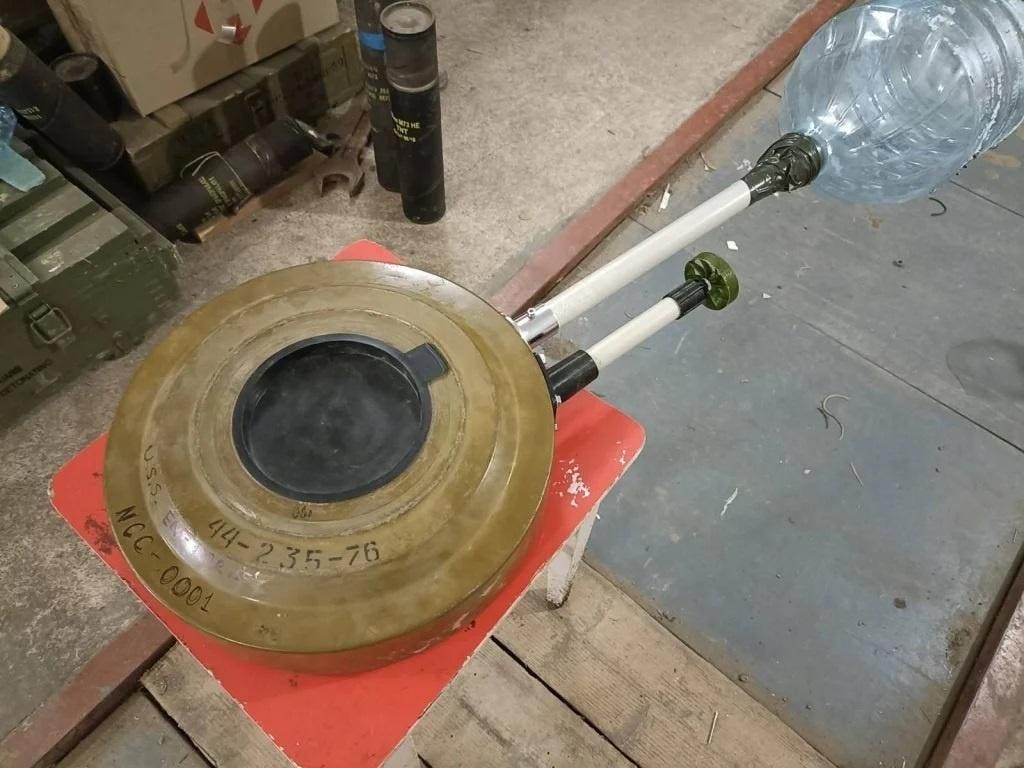The TM-62 anti-tank mine has been one of the signature weapons in this conflict. Buried or just scattered on the surface in vast numbers, the 24-pound mine has slowed attacks by both Russian and Ukrainian forces, disabling many tanks and other vehicles. Now videos show the mine being used in a way never envisaged by its Soviet developers: Ukrainian heavy drones are dropping TM-62s on Russian forces as improvised aerial bombs .
While it may lack a conventional air force, Ukraine’s drone fleet has been growing rapidly. DJI Mavics and similar consumer quadcopters drop small 30mm and 40mm grenades and FPV kamikazes can carry bigger RPG warheads, but there is also a demand for heavy multicopter bombers and Ukraine has fielded a wide variety of different types.
Ukraine’s heavy drone bombers are typically locally-made hexacopters or octocopters assembled from imported components. Two of the better known types are the Kazhan (“Bat”) and Vampire, both showcased in the Army of Drones initiative led by digital transformation minister Mykhailo Fedorov.
Fedorov recently announced that the Army of Drones was procuring 270 Vampire drones capable of carrying up to 15 kilos/33 pounds over 4 miles, or 10 kilos/22 pounds to 6 miles. The Vampire is equipped with thermal imaging for night attacks, and one was seen in a CNN news clip destroying a Russian tank with three 82mm mortar bombs.
The E620 Kazhan is also optimized for night attacks and has a maximum payload of 20 kilos/44 pounds for short range attacks. Again the standard bombload appears to be two or more 82mm mortar bombs.
This type of drone can cost $15,000 – $30,000, perhaps ten times as much as a Mavic quadcopter, but with the capability to take on far tougher targets.
Bigger Bombs For Harder Targets
Mortar bombs are highly effective against armored vehicles, but tougher targets such as bunkers and concrete emplacements require something more powerful, something which uses more of the bomber’s payload capacity for a single large munition. And that is where the TM-62s come in: a handy, ready-made munition of a convenient size to be carried by a Vampire or Kazhan.
“They have considerable blast effect so they’re useful for demo jobs,” says British military historian Matthew Moss, co-founder of The Armourer’s bench website. “They’re everywhere too, so are a readily available source of stable explosive.”
Moss notes that the heavy mines appear to be used exclusively against static targets like bunkers and checkpoints, with mortar bombs and other munitions used against vehicles. These have the advantage of giving multiple shots: if the first bomb misses the operator can adjust position for another go. The mine is all-or-nothing, but a 25-pound mine has far more destructive power than a 7-pound mortar bomb. This is partly because a mortar bomb is primarily designed to spray antipersonnel shrapnel, so it mainly metal with at most 20% explosive, whereas 80% of the TM-62’s weight is TNT or RDX explosive.
Moss has studied the air-dropped TM-62s and notes they now the arrangements for fusing and dropping them have evolved. In one version, a hole is cut in the mine casing so a hand grenade fuze can be directly inserted into the mine’s explosive. This mine is simply dropped from a tray suspended under the drone.
In another version the mines is seen with an improvised tail fine made from a length of pipe and a plastic water bottle so it falls straight down,with a larger fuse positioned next to the tail. This appears to be dropped via a sling system and is more accurate than the earlier version.
Technically it should be possible to use these drones to lay minefields, hovering lower and placing mines directly on the ground. Like the artillery-delivered Remotely Delivered Antti-Armor Mines supplied by the U.S., these could put minefields in uneplected places, such as behind Russian positions.
The power of the TM-62 can make it hazardous to the drone dropping it: the massive mine has a far greater danger radius than a small grenade. The operators are clearly aware of this, and the time taken for the mines to hit the target in the TM-62 bombing videos suggests that they are being dropped from altitudes of several hundred feet. This keeps the drone safely clear, but must reduce accuracy. There are likely to be many more misses not seen on video, but even so the accuracy of the drone bombers is notable.
The Future Is Cheap Death From Above
This type of democratized drone warfare provides the sort of extreme precision previously restricted to expensive guided weapons costing hundredsof thousands of dollars, but at low cost. Using stockpiles of old TM-62 mines – which are literally available by the truckload – means the only cost is the drones themselves, which are able to attack again and again.
It is worth noting that, prior to this conflict, no heavy bomber multicopter had ever been used in war. Now there are large numbers of several different versions and they are evolving fast. The manually-guided, operator-controlled drones are able to deliver quantities of cheap explosives. Future generations are likely to have more sophisticated software to locate targets and drop mines with even greater accuracy.
Read the full article here





